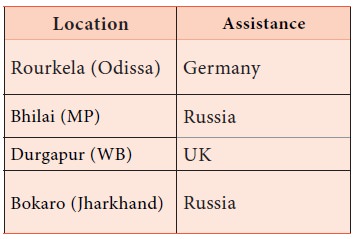Indian Economy - Large Scale Industries | 11th Economics : Chapter 8 : Indian Economy Before and After Independence
Chapter: 11th Economics : Chapter 8 : Indian Economy Before and After Independence
Large Scale Industries

Large
Scale Industries
The term “Large scale industries” refers to those industries whichrequire huge infrastructure, man-power and a have influx of capital assets. Theterm ‘large scale industries’ is a generic one including various types ofindustries in its purview. All the heavy industries of India like the iron and steel industry, textile industry, automobile manufacturing industry fall underthe large scale industrial arena. However in recent years due to the IT boom andthe huge amount of revenue generated by it the IT industry can also be includedwithin the jurisdiction of the large scale industrial sector. Indian economy is heavily dependent on theselarge industries for its economic growth, generation of foreign currency and forproviding job opportunities to millions of Indians. The following are the major large scale industries in India.
1. Iron and steel industry
·
First steel industry at Kulti, Near Jharia,
West Bengal - Bengal iron works company in 1870.
·
First large scale steal plant TISCO at
Jamshedpur in 1907 followed by IISCO at Burnpur in 1919. Both belonged to
private sector.
·
The first public sector unit was “Vishveshvaraya
Iron and Steel works” at Bhadrawati.
Public sector steel plants


·
All these are managed by SAIL (at present
all important steel plants except TISCO, are under public sector)
·
Steel Authority of India Ltd (SAIL)
was established in 1974 and was made responsible for the development of the
steel industry.
·
Presently India is the eighth largest steel
producing country in the world.
2. Jute industry
·
Jute industry is an important industry for a
country like India, because not only it earns foreign exchange but also
provides substantial employment opportunities in agriculture and industrial
sectors.
·
Its first modernised industrial unit was
established at Reshra in West Bengal in 1855.
·
The jute industry in the country is traditionally
export oriented. India ranks number one in the raw jute and jute goods
production and number two in export of jute goods in the world.
3. Cotton and textile industry
·
Oldest
industry of India, and employs
largest number of workers.
·
It is the largest organised and broad-based
industry which accounts for 4% of GDP, 20% of manufacturing value-added and one
third of total export earnings.
·
The first Indian modernised cotton cloth
mill was established in 1818 at Fort Gloaster near Calcutta. But this mill was
not successful. The second mill named “Mumbai’s Spinning and Weaving Co.” was
established in 1854 at Bombay by KGN Daber.
4. Sugar industry
·
Sugar industry is the second largest industry
among agriculture-based industries in India.
·
India is now the largest producer and
consumer of sugar in the world. Maharashtra contributes over one third of the
Indian total sugar output, followed closely by Uttar Pradesh.
5. Fertiliser industry
·
India is the third largest producer of
nitrogenous fertilisers in the world.
6. Paper industry
·
The first mechanised paper mill was set up
in 1812 at Serampur in West Bengal.
·
The paper industry in India is ranked among the 15
top global paper industries.
7. Silk industry
·
India is the second-largest(first being
China) country in the world in producing natural silk. At present, India produces
about 16% silk of the world.
·
India enjoys the distinction of being the only
country producing all the five known commercial varieties of silk viz Mulberry,
Tropical Tussar, Oak Tussar, Eri and Muga.
8. Petroleum and natural gas
·
First successful Oilwell was dug in India in 1889
at Digboi, Assam.
·
At present a number of regions with oil
reserves have been identified and oil is being extracted in these regions
·
For exploration purpose, Oil and
Natural Gas Commission (ONGC) was established in 1956 at Dehradun, Uttarakhand

Related Topics